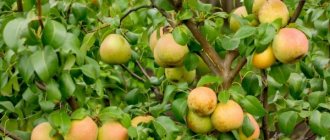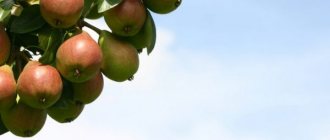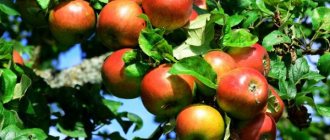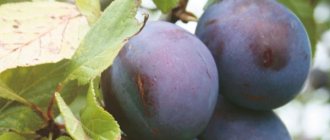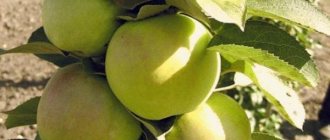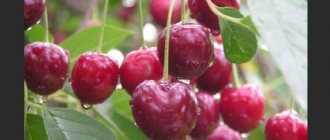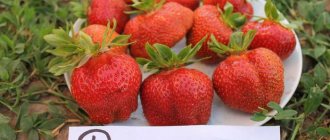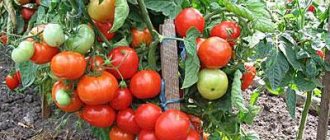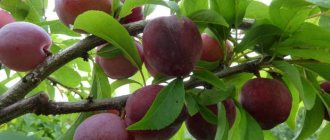Work on developing the Severyanka red-cheeked pear variety was carried out at the Michurinsky Center for Selection and Genetics of Fruit Plants, authorship belongs to P.N. Yakovlev. Pear Severyanka red-cheeked" was accepted for state testing at the end of the last century and zoned for the Central Black Earth region. It is worth noting that the climate of this region is suitable for growing many other varieties, including Duchess, Bere Russkaya, Extravaganza, Quiet Don, Skorospelka from Michurinsk and many others.
So far, in the debate for popularity, the apple tree is winning over the pear tree, since pear trees are more heat-loving and less common fruit crops. But thanks to the continuous work of breeders, more and more new varieties are appearing that have many advantages in addition to the excellent taste of the fruit and are able to survive in the most unpredictable climate.
Today we will talk about the Severyanka red-cheeked pear, which is loved by summer residents for its unpretentiousness, productivity and beautiful and tasty fruits.
What type of pear is it?
Northern red-cheeked is a summer type of pear .
Summer varieties also include: Limonka, Victoria, Cosmic, Carmen and Children's.
The growing area for Severyanka red-cheeked is the Central Black Earth region. In the future, the prospect of replacing the common Severyanka variety in a number of regions with a variety bred as a result of selection is being considered.
How to care for a pear
Caring for the Severyanka variety is not difficult even for young, inexperienced gardeners.
- Watering is carried out 2-3 times a month. Place 1-3 buckets of water or more under the tree, so that the ground is well saturated with water. It should be taken into account that the Northern Red-cheeked pear can tolerate short-term drought. But it is advisable not to aggravate the situation. If a tree is not watered for a long time, it begins to reduce its yield, young branches may die, and its resistance to disease decreases.
From time to time you need to loosen the tree trunk area
- From time to time you need to loosen the tree trunk area. All weeds must be removed. If possible, mulch the ground near the trunk. It is best to use peat or humus as mulch.
- Tree pruning is essential. The first 3-5 years form the crown of the Severyanka pear so that it is neat and beautiful. Then mostly sanitary pruning is carried out. It is necessary to cut off at least once a year all damaged, dry, twisted pagons.
- Once a season, it is important to feed the tree with minerals (preferably in the spring). In the fall, before wintering, humus is added to the tree trunk circle for digging.
History of selection and region of breeding
This variety was obtained by crossing the Red-cheeked and Severyanka . Its founder is considered to be the breeder P.N. Yakovlev , academician of the All-Russian Center for Selection and Genetics of Fruit Plants named after Michurin .
The samples have been undergoing state variety testing since 1998.
The following pears are suitable for planting in the Central Black Earth region: Duchess, Bere Russkaya, Feeria, Quiet Don and Skorospelka from Michurinsk.
Description of the variety Severyanka red-cheeked
Let us consider separately the appearance of the tree and the fruit.
Tree
Small size. The northern red-cheeked pear reaches its maximum height at the age of 14 years - 5-6 meters. More intensive growth is observed in width.
Wide trunk and strong branches. The diameter of the tree can often be more than 6 meters. The crown shape is pyramidal. The branches are distinguished by their small thickness and medium density. They are attached to the trunk quite firmly and deviate to the side at a large, almost right angle.
Bark of dark shades. The color of the bark varies from brown to gray.
Dark green shiny leaves. They are oval in shape with clearly defined sharp tips and are medium in size. The leaf plates are straight, without bends, and the edges are jagged.
White flowers of medium size. The flowers grow in groups of 5-6 pieces and are saucer-shaped . The peduncle is quite long.
A distinctive feature of flowers is their resistance to low air temperatures. The tree has an early flowering period - in April and May.
Brown shoots of medium thickness. There is practically no curvature of the shoots. The tips of the buds are sharp. The tree has high rates of shoot formation.
Fetus
The pear variety Severyanka red-cheeked is distinguished by small-sized fruits . Typically, pears of this variety are below average in size. The average weight ranges from 85 to 120 grams.
The shape is oval, the skin of the fruit is smooth, dense and not rough. At the time of harvest, pears are light yellow in color, sometimes yellow-green. The color of the fruits may turn red in some places if they hang for a long time on the sunny side.
The redness is distributed in the form of spots and streaks, which is why this pear variety got its name - Severyanka red-cheeked.
Inside, the pulp is creamy in color and sufficiently juicy.
Pear seeds are large, brown and ovoid in shape. The taste of the fruit is sweet, but there is a sourish tint. The aroma is quite pronounced.
The following varieties can boast of excellent taste: Krasulya, Lyubimitsa Yakovleva, Karataevskaya, Vernaya and Kupava.
ATTENTION! Pears of this variety are distinguished by good transportability.
Diseases and harmful insects. Prevention.
Like most hybrid varieties, Severyanka red-cheeked pear is resistant to most fungal infections, including scab. But according to the observations of specialists and amateur gardeners, in some years pear trees are affected by septoria. If such a problem occurs with your tree, then after harvesting you must immediately remove all the affected leaves (all fallen leaves should also be collected) and burn them. After this, the tree must be treated with a preparation containing copper (Bordeaux mixture, copper sulfate).
It is important for every gardener to know that the microorganism that causes septoria blight overwinters on fallen leaves that you did not remove in the fall. In spring, during rains, trees become infected and the disease develops. Therefore, maintaining cleanliness in the garden and destroying all plant debris is the main and one of the most effective preventive measures.
To avoid the appearance and spread of unwanted insects, you should spray the tree with a complex-action insecticidal preparation in the spring before flowering begins.
Photo
Characteristics
Pear trees begin to bear fruit regularly 5 years after planting.
The tree has an early flowering period - April, May .
The fruit ripening season is summer, mid-August. The fruits must be consumed within two weeks.
The yield of eight-year-old Northern red-cheeked is about 120 c/ha.
The seedling is 2 years old and its height is up to 160 cm.
IMPORTANT! The variety has a need for pollinators due to its low independent fruiting rate. The best one is In Memory of Yakovlev .
This type of pear has high frost resistance , which is slightly inferior to Severyanka.
The advantages of the variety are early ripening, frost resistance, resistance to scab, pleasant appearance of pears and versatility of use. The main disadvantage is the small fruits.
The following varieties can also boast of high productivity: Bere Bosk, Yanvarskaya, Uralochka, Tonkovetka and Svetlyanka.
Diseases and pests
The variety has good disease resistance, but to maintain strong immunity, it is necessary to regularly carry out preventive measures. In the articles selected below, you can find tips on protection and prevention.
Dangerous Pear Pests
Pears often suffer from pests, they affect the leaves, bark and fruits.
In this article, we have selected 11 of the most harmful insects that harm pear trees, and also ways to destroy them.
Diseases of pear trees
To get what they cherish, gardeners have to work hard, and the reason for this is pear diseases.
Read about 19 common pear diseases and how to combat them.
Planting and care
It is necessary to plant Severyanka red-cheeked in a sunny, dry and gently sloping place.
The tree is not demanding when it comes to soil, but it is advisable to choose nutrient-rich, well-drained areas.
IMPORTANT! Abundant moisture and moisture concentration in the soil have an adverse effect on the condition of the pear. Therefore, in lowlands where there is a high level of groundwater, the tree most often does not take root.
It is best
to plant seedlings in a permanent place, since the tree does not like being transplanted. If planting is still done in the spring, it must be done before buds form.
The hole for planting needs to be dug large (100-120 cm deep and about 80 cm in diameter ).
3 buckets of humus, up to two hundred grams of superphosphate and calcium chloride, and up to 1 kg of organic fertilizer are added to the pit
All this is pre-mixed with soil taken from the pit.
Before planting, a small mound is formed in the hole, on which the seedling is placed. The roots are spread evenly. The root collar should rise above the soil level by about 6 cm. Then the roots are covered with soil, which is then very carefully trampled underfoot.
At the end of planting, a small depression is made around the tree trunk. It is necessary to water the soil immediately. The pear tree needs to be watered abundantly for the first two months.
The tree loves loosening, constant watering, and fertilizing with organic matter, potassium, and phosphates.
Since the Northern red-cheeked tree has a high degree of shoot growth, the tree needs constant pruning of very thick branches.
Young pears are prone to freezing in winter, so they need to be covered with a large layer of snow and the trunks covered.
Advantages of Severyanka pear
Also check out these articles
- Mallard duck
- Palm Chamaedorea
- Growing dill in a greenhouse in winter
- Arabian horse breed
The Severyanka pear variety is known to farmers as a productive variety with a lot of positive qualities.
- The fruits ripen early.
- The trees are small, making them easy to care for and harvest.
- The beginning of fruiting is observed from 3-4 years after planting.
- Productivity is high. At the 7th year of life, the tree bears up to 20 kg of fruit, a 10-year-old tree can produce up to 60 kg of pears per year, and in particularly fruitful years, about 110 kg of delicious pears are harvested from the tree.
Interesting!
The crop is partially self-fertile, but the tree itself produces only 35% of the harvest. To increase productivity, you still need to plant pollinators nearby - pear varieties that have the same flowering period.
- Winter hardiness is very high. The tree can withstand frosts of -40 degrees without problems. During a cold winter, the crown may freeze, but the root system survives frosts of -45 degrees!
The tree can withstand frosts of -40 degrees without problems
- Drought resistance is average.
- The tree is practically not affected by scab.
- There is resistance to pests such as pear mites or codling moths.
